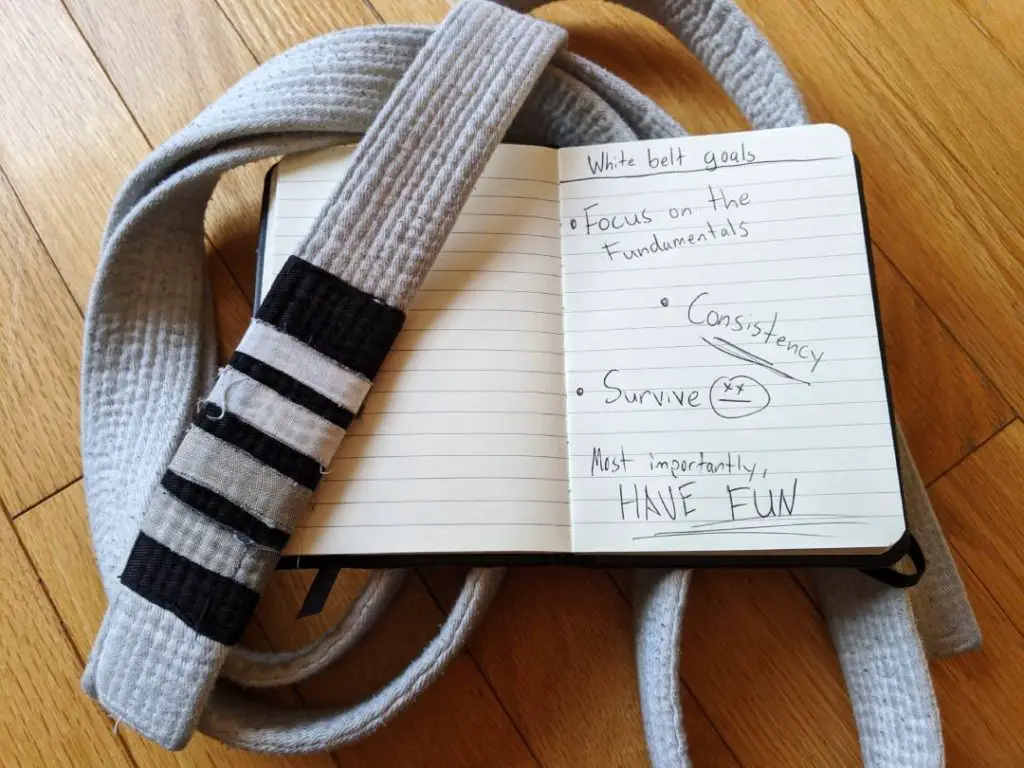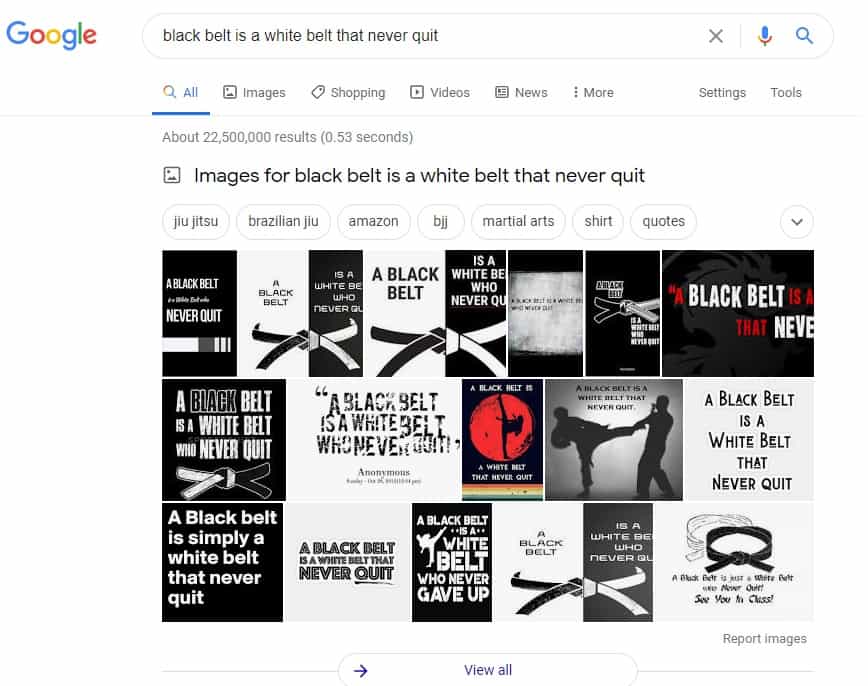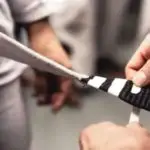Goals are important to have, it gives us something to strive towards. Maybe you’ve just started Brazilian Jiu-Jitsu or have been training for a few months, or even a year when you start to wonder, what should your goal be? Is it the next stripe? The blue-belt?
The primary goal for a Brazilian White-Belt is to survive by learning escapes, using frames, creating space, learning to breathe, and staying calm. Next, coming to class consistently will make the difference between getting your next stripe and never showing up again. Finally, absorb as much as you can and concentrate on the fundamentals to learn to survive.
- Focus on the fundamentals
- Come to class consistently
- Learn to survive
In this article, I will cover those 3 goals and why they are important for a white-belt, but also know that the goal above all is to enjoy yourself!

What Does Surviving In BJJ Mean?
Surviving is learning how to prevent positional advancements, escape from positions, fight for dominant grips, and hold dominant positions. Furthermore, focusing on remaining calm when under pressure, flow in your movements, remembering to breathe and pacing yourself will be key to success.
Surviving in Brazilian Jiu-Jitsu does not mean you roll up in a ball protecting your neck. Although, you should know how to protect your neck!
Learning To Escape
Escaping will be your primary focus during most of your white-belt journey, especially in your first year and particularly if your gym allows mixed classes (white-black belt levels). Learning to bridge, frame, wedge, and shrimp to create space to escape from various positions is the most important thing you’ll learn at the white belt level.
Prevent Positional Advancements
Preventing positional advancements in BJJ is a fundamental skill every white-belt should learn. The most basic example of this is learning how to retain your guard. Retaining your guard means keeping your opponent in it and if they manage to escape it, learning how to regain it or sweep them.
Dominant Grips And Positions
Grips fights and positional battles happen throughout the entire roll and the person that wins those small battles get the advantage. Every technique whether it is passing someone guard or setting up an armbar will require proper grips and positional control.
Typically dominant positions are top positions; however, there are always exceptions. Everyone has their style and some are deadly from the bottom. A great example is Eddie Bravo’s bottom half-guard.
If you want to learn more about the positions in Jiu-Jitsu check out my article going over them.
The battle with Ryan Hall vs Jorge Britto is an excellent display of grip battling and how dominant grips can lead to a dominant position, leading to a submission.
Remain Calm And Breathe
Remaining calm and remembering to breathe is important in Jiu-Jitsu as it will allow you to spend less energy on more effective movements and prevent you from getting winded in the process.
Staying calm and concentrating on using techniques to advance your position will allow you to train more effectively. Many new BJJ students “spaz” or flail around which is understandable as they do not know any techniques. Furthermore, being pinned down is not a fun position to be in and can also cause panic.
But, this can be dangerous for training and it is ineffective. Ask your training partner what you should do in that position if you do not know and notice yourself starting to flail around or panic.
And then there is breathing.
One of the silliest things you forget to do in Jiu-Jitsu is remembering to breathe. From learning new techniques, drilling and rolling, you will catch yourself holding your breath.
Holding your breath will cause you to get fatigued quicker making it much more difficult to perform techniques, especially when it comes to escapes.
Consistency
Consistency is the best way to become successful and that is especially true for Brazilian Jiu-Jitsu. You will hear many black belts say, a black belt is a white belt that never quit. Consistency will keep techniques fresh in your mind, your body familiar with the movements, and form the habit of going to train.

It’s easy to stop coming to class one day because you are too tired, which can form a habit to not come to class at any time you are tired. If you’re like me and most humans in the world, you’re always tired, especially after a long day at work!
Remember that feeling you get during and after class? Use that to keep coming back.
Remember that feeling you get after you miss a class? Use that to keep coming back on those days your motivation is low.
Staying consistent is knowing how much training is right for you. It can be easy to train too often and burn yourself out, usually in the first 6 months of Jiu-Jitsu because of the excitement of learning something new. Burnout usually leads to people not enjoying the hobby as they once did. After that feeling sets in you’ll need and want to take a day off.
Unfortunately, getting tired of doing the activity you once enjoyed and taking time off can cause you to take a week off. Then one more week just to make sure you’re fully recovered.
The longer you are away the more you feel you are falling behind making you think you shouldn’t go…
Find a training schedule for you that can be maintained long term. 6 months of training hard are nothing compared to training twice a week for 10 years.
If you need further help I have an article about, how often should you train Jiu-Jitsu!
Fundamentals In Brazilian Jiu-Jitsu
The fundamentals in Jiu-Jitsu are:
- Basic movements and positions
- Frames and how to use them
- Proper basing
- Importance of posture
- How to protect yourself
Basic Movements And Positions
The basic movements in BJJ are bridging, shrimping, rolling, and falling. Knowing how to bridge will create space for frames and wedges. Shrimping is another method used to create space by freeing space around your hips which can allow you to bring in knee shields and additional wedges. Finally, learning how to roll and fall will prevent injuries from knowing how to land to distribute the impact more evenly across your body and how to tuck your head safely.
Frames
Framing properly in BJJ will allow you to keep the space you’ve created from bridging and shrimping form preventing your opponent from advancing their position on you. Knee shields and wedges will prevent your opponent from freely moving by either keeping distance or filling space.
Posture
Good posture in BJJ will prevent your body’s structural integrity from being broken down and keep your neck safe from chokes. Defending against grips that will pull your body down will mean the difference between your opponent getting the upper hand or you progressing your position.
Protecting Yourself
Learning to protect yourself in BJJ is crucial to survival. It’s important to know where your neck is venerable and how to protect it or where you can safely push on your opponent vs when they can snatch up your arm to get an armbar.
By the time you are at the blue-belt level, you’ll have a good understanding of this, not perfect by any means, but much better than when you first began. It takes time to learn how to protect yourself and a lot of it will come from getting caught in those situations.
Whenever someone submits you, especially with the same submission multiple times ask how they are getting that submission on you. More often than not you’re consistently leaving an opening that they can capitalize on.
One night I found one of my major flaws. Five different people in one night put me in either a guillotine or D’arce choke. Turns out I was leaving my head down and typically below chest height and every person took advantage of that in the same way. After the fifth time, I asked my teammate how he got it on me and he told me my flaw.
Time to practice keeping my posture and head in the right position to protect myself!
Conclusion
The main goal a white-belt should have in Brazilian Jiu-Jitsu is to focus on how to control and escape a position, create space with bridging and shrimping, control space with frames and wedges. Learning proper basing and using proper posture will give you an understanding of weight distribution and structural integrity.
Start and maintain a realistic, consistent training schedule to ensure you do not over-train and have dedicated days for Jiu-Jitsu. Training three times a week for many people seems to be the sweet spot for training. If you’re brand new to Jiu-Jitsu starting with two or even one may be more realistic until your body adjusts to the new movements and demands on the body.
Next, your goal at white-belt should be to learn to survive. Your blue-belt will typically come after 2+ years of training and by then you’ll start to notice that when rolling with most other students you are no longer the nail. You begin to be the hammer.
Finally, the goal to hold over all the goals listed above is to enjoy yourself!


